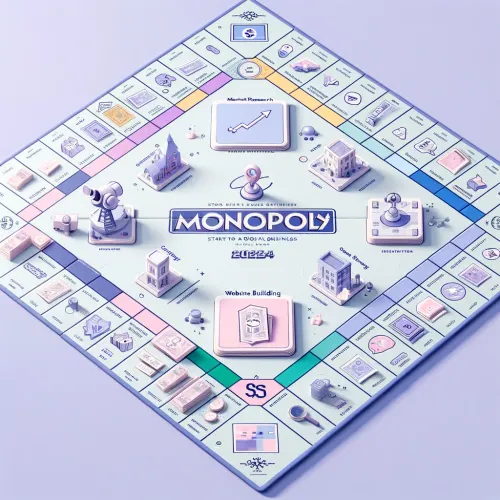🤟🏻 Hey! It is Karin here. Welcome to my ✨ newsletter ✨. This is the place where I humbly tackle topics around product, business, personal finance and spirituality. Subscribe today to get each and every issue.
2024 is a wonderful time to start a business.
We have YouTube, bringing the world's videos to our fingertips. The greatest world university and a never-ending resource to learn whatever we want.
Online, passionate creators share their knowledge. And offer customized education tailored to our unique interests.
AI has given us a never-sleeping, forever-patient assistant. It helps us ship products as cheaply and quickly as never before.
Still, where do you start?
I am here to offer you guidance. To offer a map amidst the chaos and a helping hand to guide you through the uncharted territory.
Starting today and for the next 5 weeks, I am going to share a playbook of how to go about starting a digital business in 2024.
This work is the result of my own experience building successful and not-so-successful digital products. Both the rookie and the expensive way. It is also the result of me talking to experts and synthetizing those conversations into these lessons.
Here is what you can expect:
Step 1: Welcome an idea - On gaining an insight --> This part
Step 2: Audit your idea. On figuring out if you have an idea worth pursuing?
Step 3: Find your audience. On how to identify your who and building empathy
Step 4: Build a product. On how to validate your solution and nail a value proposition
Step 5: Resonance - On finding the message that resonates with your audience
I cannot promise you success. I don't have a crystall ball. I simply find this a helpful framework to see the journey ahead of me.
Lets start!
Step 1: Welcome an idea - Gain an insight

If you are lucky enough to have an idea already, skip this part and go to step 2.
Else, don't despair. There is an active and a passive way of coming up with ideas.
Active way:
The active way of getting ideas is about turning on your radar to notice problems. You want to build a solution for a problem that many people have.
Below, are six strategies that you can use to activate your problem-radar. These will get you into the mode of seeing the problems we learned to live with that need a solution.
1. Notice the problems you face
Experiment with going about your day noting down what problems YOU face.
This works because you want to avoid solving a problem that doesn't exist or nobody has. If you have a problem, then that is already one person having that problem.
Expand on this by reflecting on problems you observe in your professional day. Extend this to your previous jobs and meaningful life experiences:
- What problems did you come across that nobody else saw?
- What did you learn that other people who were not in your position don't know?
- Are there opportunities that you are in a special position to see?
Engaging with these questions helps you find something where you might have an unfair advantage or a unique insight. Focusing on your area of expertise, increases your chances of executing well.
Apple is a good example of this. Steve Wozniak couldn’t find a computer he was happy with, so he built his own. (Source: Byte Magazine)
2. Notice the problems your audience faces
Join the communities where the people you want to serve hang out. Engage there and observe the things they complain and rave about. This is valuable because you might grasp first-hand the topics that concern them.
- Are there any gaps in current solutions that they point to?
- What are alternative solutions they are hacking for themselves?
- How can you add value?
Take Instagram as an example. Back in the days when it was called Burbn, its founder Kevin Systrom noticed that users were using the app mostly to share filtered photos. Burbn used to let users check-in at places. They could make plans for future check-ins and earn points for hanging out with friends. They could also post pictures of the meet-ups. But people were not using all these features. They were not checking in. They were sharing filtered photos. (Source: Startups.com).
3. Think of things you would like to see in the world
Pursue your curiosity and delve into what you believe is lacking in the world. Pay close attention to what that might be. Build something around that fast and observe how the world reacts to it.
Doordash is an example of this. The founders wanted to order food from local restaurants and get it delivered to their dorm. Back then, you couldn't do that. So they decided to do it themselves.
Be aware, though that this is the least "validated" way. You risk diving into your passions instead of a real problem.
If going down this route, give yourself time to tinker. Don't limit yourself to thinking, also go and build something. And test it as cheaply and quickly as you can. Most likely, your first idea won't be right. So be ready to toss it and replace it with a different version.
4. Get inspiration from other countries
Use the globalised world we live in as a source of inspiration. There are innovative teams everywhere. Most of them launch their products and services in specific regions. You might decide to bring these to different countries.
Observe what products are growing fast and getting traction in different countries. It is perfectly fine to copy them and execute them somewhere else. Don't forget to “tropicalizing” them a.k.a adapt them to your local context.
I come from Latin America and live in Germayny since 10 years. I have come to observe that many products arrive there with roughly 10 years of delay. This was the case for neo-banks, food delivery and e-commerce. I am pretty sure it will the case for electric cars and some of the applications of AI. It can also work the other way. Rappi, a Colombian unicorn, inspired many last-mile delivery services in other regions.
The Samwer brothers built their German empire on this strategy. Rocket Internet, their incubator, took and copied ideas from elsewhere. They considered them to be already validated and proven. For example, Zalando copied Zappos and Amazon. Lendico imitated LendingClub and Belveda Treatwell. And Wimdu leaned heavily on AirBnB.
5. Build something that sparks your joy and double down on what works
Build whatever you want (and can) and be ruthless about doubling down on what is working confident that it will lead you somewhere.
Lets take the example of YouTube. Most people don't know that it started as a dating site. The reason being that Steve Chen (one of the co-founders) wanted to build a dating app. He thought the video format would add value to dating platforms.
“I remember trying to recruit users to come to YouTube for that reason. We quickly realized that a dating platform wasn’t in demand of videos as the media type so we opened up the app to go after all types of content creators.”
Source: Steve Chen, CoFounder
YouTube quickly dropped the dating aspect opening the platform to all types of video content. This move made it the world greatest video sharing platform.
If you go down this route, you need to ruthless about killing your idea. Even if you love it, you need others to love it too.
Also don't take for granted what works. If you see traction or retention, remember that that is a rare find. Double down on that and forget everything else.
6. Go analytical.
You can go talk to people and listen to the problems they have. For this to be more efficient, you should narrow the space down to some sectors. And then talk to anyone in that sector who is willing to talk to you. Use those conversation to build a map of that space and identify opportunities.
Passive way
This section is going to be more spiritual and less direct. But I genuinely believe it can work.
First, understand that there is a way of putting yourself in "reception" mode. A state of open perception, without judgment.
This mode activates for me after walking in nature, meditating, or during a massage. You might have different ways of activating it (e.g.: long drives, taking a shower, or even brushing your teeth or hair). Learn what works for you.
Second, make the deliberate decision to activate that mode. Make the time and enjoy the ride. Observe what thoughts and ideas reach you.
Why does this work?
Our brain produces five types of waves, each at different speeds or frequencies. We spend most of our waking hours in the alpha or beta wave frequency. But there is another frequency that allows us to perceive the world differently: the theta wave frequency. It is a state that fosters an open reception of a flow of ideas, without self-censorship or guilt. With some practice, you can leverage this mode to put yourself in a receptive mode.
Once you are there, make mental notes of the ideas that cross your mind and note them down. Without judgement
You've got an idea. What should you do with it?
First, embrace it.
This idea found you because it saw potential in you to bring it to life. Relish that feeling and connect with your potential.
Next, make it feel welcome. Write it down and share it with others. Give it space to grow and imagine how you could bring it to life.
Avoid judgement. Spend time with the idea, allow it to express itself and try to visualize it as much as you can. Listen and observe without judgement.
Don't rush to decide on its feasibility. Allow the idea to breathe and take up space.
Observe if it remains with you.
Determine if it's important enough for you to act upon.
If you decide to act, it's time to evaluate the idea.
Next week: 🕵🏽♀️ Audit your idea. On figuring it out if it is a good idea.
Finding this newsletter valuable? Share it with friends or subscribe
Sincerely,
Karin 💐

